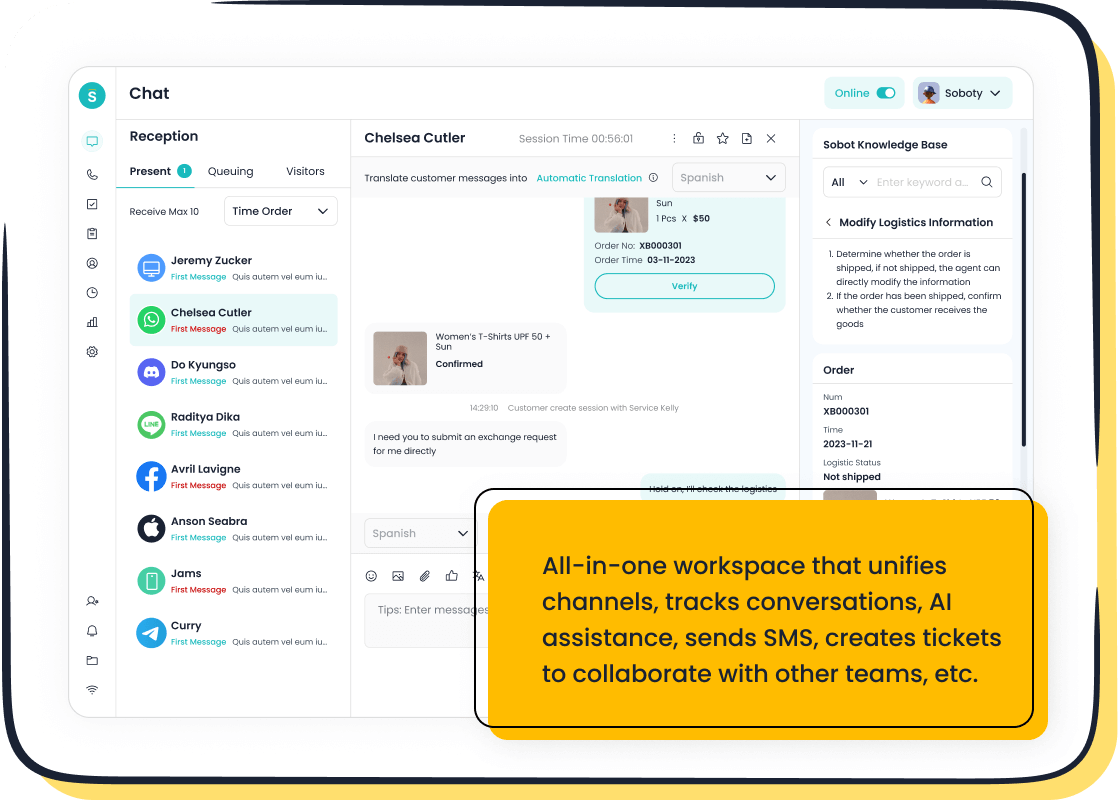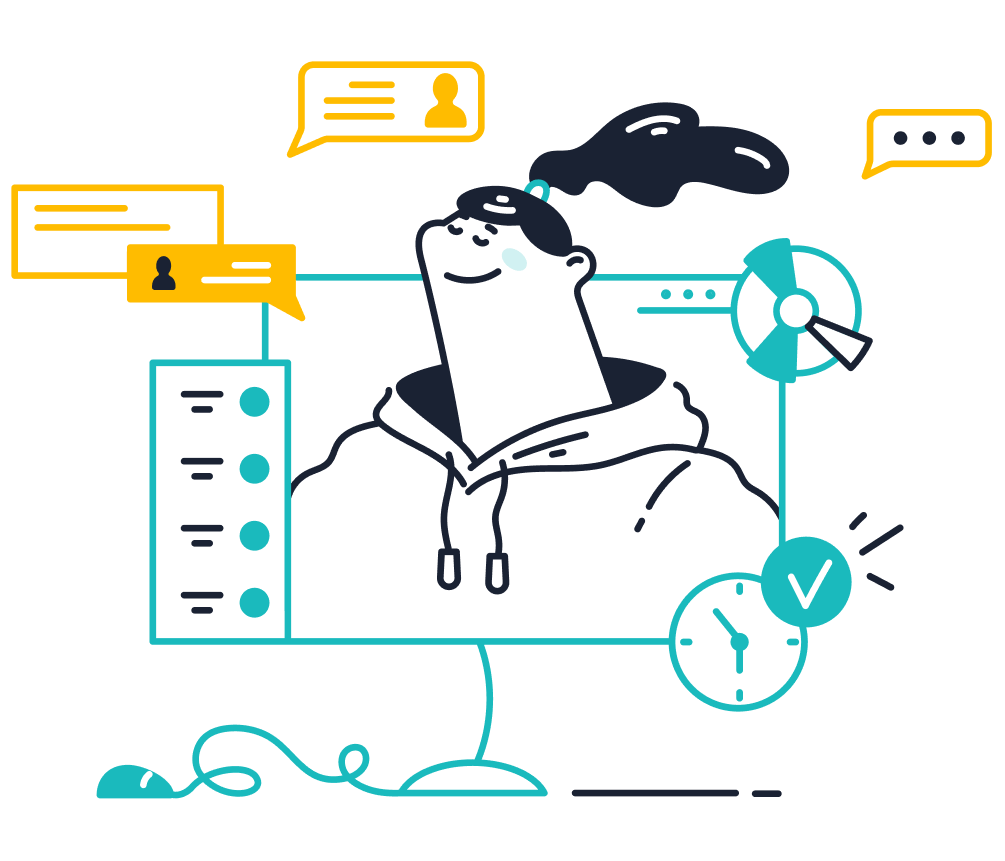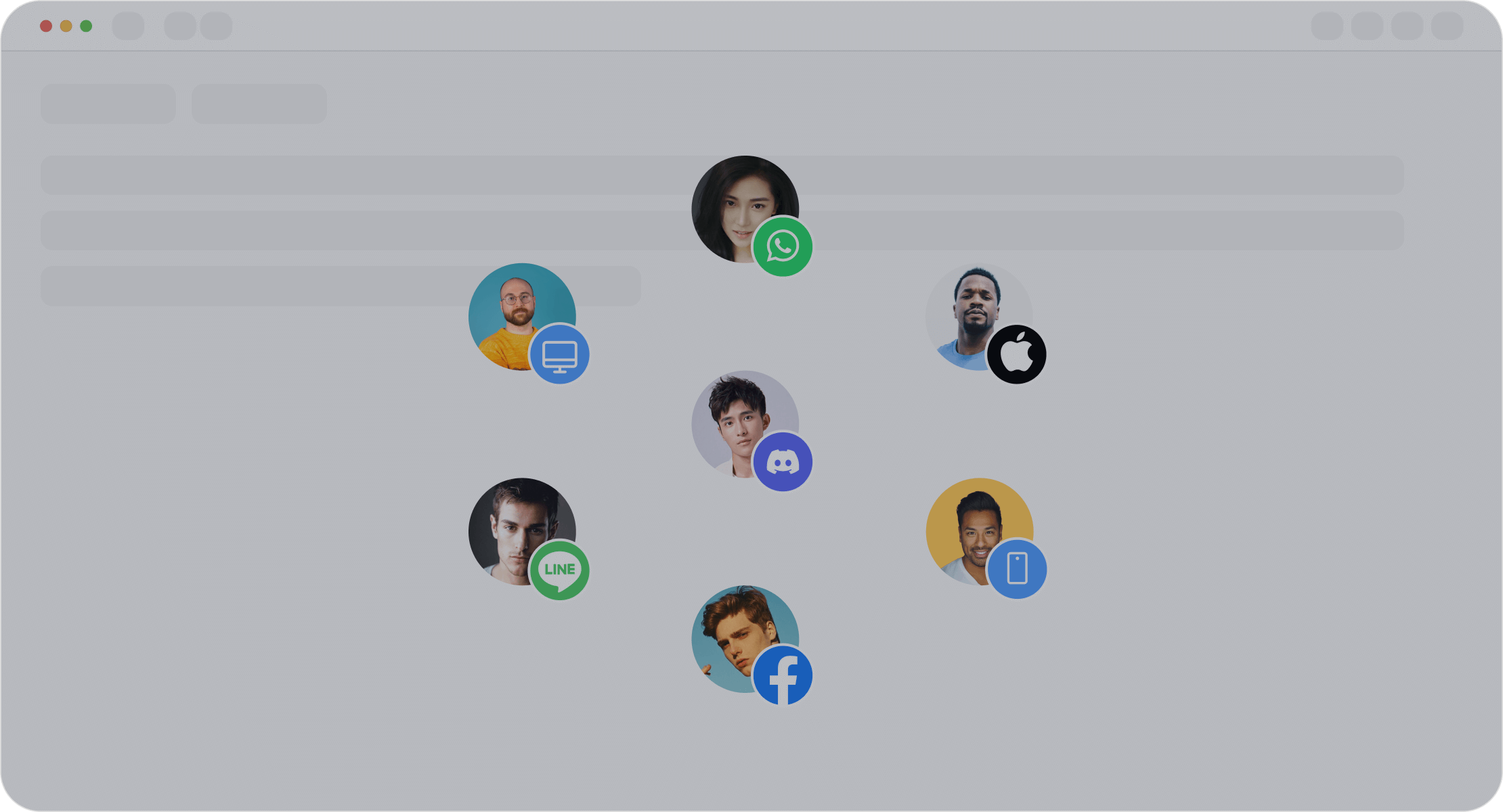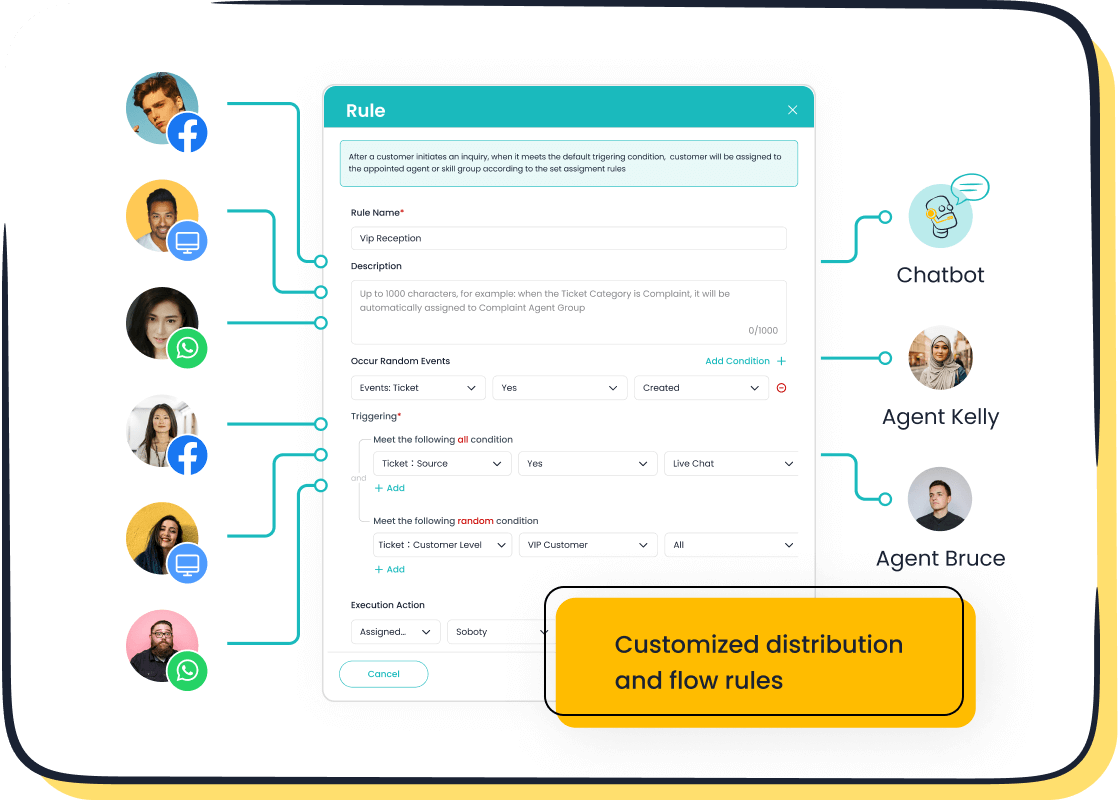How to Maximize Cross-Sell Success Rate for Small Businesses

Cross-selling is a game-changer for small businesses looking to boost revenue without the high costs of acquiring new customers. Did you know selling to existing customers is 60%-70% more likely to succeed than selling to new ones? Plus, businesses using cross-selling strategies often see a 20% profit increase. But it’s not just about revenue—it’s about creating a satisfying experience that keeps customers coming back. Personalized recommendations, for example, can increase sales by 35% and build loyalty. Tools like Sobot Live Chat make this easier by helping you understand customer needs and offer tailored suggestions, improving your cross-sell success rate (xsr).
Understanding Cross-Selling and Its Benefits

What Is Cross-Selling?
Definition and how it differs from upselling.
Cross-selling is the practice of recommending complementary products or services to your existing customers. It’s about offering items that enhance or complete their purchase. For example, if someone buys a smartphone, suggesting a protective case or wireless earbuds would be cross-selling.
This differs from upselling, which focuses on encouraging customers to purchase a higher-end version of the product they’re considering. While upselling aims to maximize revenue by increasing the value of a single item, cross-selling broadens the scope by adding related products to the cart.
Examples of cross-selling in small businesses.
Small businesses can use cross-selling in creative ways. A coffee shop might suggest a pastry to go with a latte. A boutique could recommend a matching scarf when a customer buys a coat. Even service-based businesses can cross-sell—think of a salon offering a deep-conditioning treatment alongside a haircut. These strategies not only boost revenue but also build trust by showing you understand your customers' needs.
Why Cross-Selling Matters for Small Businesses
Boosting revenue without acquiring new customers.
Cross-selling is a cost-effective way to maximize revenue. Selling to existing customers is far easier than acquiring new ones, with a success rate of 60-70% compared to just 5-20% for new prospects. McKinsey research shows that effective cross-selling can increase revenue by 20% and profits by 30%. By leveraging your current customer base, you can achieve significant growth without additional marketing expenses.
Enhancing customer experience with tailored recommendations.

When you offer personalized suggestions, customers feel valued. This enhances their shopping experience and encourages them to spend more. For instance, using tools like Sobot Live Chat allows you to analyze customer preferences and provide tailored recommendations in real time. This not only increases sales but also helps build trust and loyalty.
Strengthening customer loyalty and retention.
Cross-selling strengthens relationships by showing customers you understand their needs. Offering relevant products or services keeps them engaged and satisfied. According to studies, businesses that focus on cross-selling see higher retention rates and increased customer lifetime value. This strategy ensures your customers keep coming back, turning one-time buyers into loyal advocates.
Knowing Your Customers to Improve Cross-Sell Success Rate (XSR)
The Role of Customer Data
Using data to understand buying patterns.
Understanding customer purchasing behavior is the foundation of successful cross-selling. By analyzing data like purchase history, browsing habits, and transaction frequency, you can uncover patterns that reveal what your customers truly want. For instance, if a customer frequently buys skincare products, they might be interested in related products like facial masks or serums. Tools like Sobot Live Chat can help you track these behaviors in real time, making it easier to offer relevant products when it matters most.
Data analytics also provides insights into key metrics that influence cross-sell success. Metrics like Customer Lifetime Value (CLV) and Average Order Value (AOV) highlight which customers are most likely to respond to cross-selling tips. Predictive analytics takes this a step further by forecasting future buying behaviors, helping you identify cross-sell opportunities with precision.
Identifying complementary products or services.

Once you understand buying patterns, the next step is identifying complementary products. These are items that naturally pair with what your customers already purchase. For example, a customer buying a laptop might also need a laptop bag or a wireless mouse. By offering these product recommendations, you not only increase sales but also enhance the customer experience. Sobot Live Chat’s AI-assisted tools can suggest complementary products instantly, ensuring your offers are timely and relevant.
Segmenting Customers for Targeted Offers
Grouping customers based on preferences and purchase history.
Not all customers are the same, so why treat them that way? Segmenting your audience based on preferences, demographics, or purchase history allows you to tailor your cross-selling strategies. For example, a clothing store could group customers into categories like casual wear buyers and formal wear enthusiasts. This segmentation helps you craft product recommendations that feel personal and thoughtful.
Creating personalized cross-sell offers for each segment.
Once you’ve segmented your customers, you can create targeted offers that resonate with each group. Personalized cross-sell offers are far more effective than generic ones. Imagine sending an email to a customer who recently bought a smartphone, suggesting a protective case or screen protector. These relevant products not only boost sales but also show your customers that you understand their needs. Tools like Sobot Live Chat make this process seamless by unifying customer data and enabling personalized interactions across multiple channels.
Listening to Customer Feedback
Refining cross-sell strategies based on feedback.
Customer feedback is a goldmine for improving your cross-selling efforts. Surveys, online reviews, and even casual conversations can reveal what your customers like or dislike about your product recommendations. For example, if customers mention that certain suggestions feel irrelevant, you can adjust your strategy to focus on more suitable options. Using data analytics to measure key performance indicators (KPIs) like conversion rates ensures your cross-sell strategies stay effective.
Avoiding irrelevant or pushy recommendations.
Nobody likes feeling pressured into buying something they don’t need. Pushy or irrelevant cross-selling can harm your relationship with customers. Instead, focus on offering related products that genuinely add value to their purchase. For instance, if a customer buys a coffee maker, suggesting premium coffee beans feels natural and helpful. Sobot Live Chat’s built-in analytics can help you refine your approach, ensuring your recommendations are always on point.
Tips and Strategies to Boost Cross-Sell Success Rate (XSR)
Personalizing Cross-Sell Offers
Leveraging tools like Sobot Live Chat for tailored recommendations.

Personalization is the cornerstone of effective cross-selling. Tools like Sobot Live Chat make personalizing on-site offers seamless by analyzing customer data in real time. This platform uses AI to track browsing behavior, purchase history, and preferences, enabling you to recommend upsell and cross-sell options that feel natural. For instance, if a customer is browsing skincare products, Sobot Live Chat can suggest complementary items like serums or moisturizers. This approach not only improves the cross-sell success rate (XSR) but also enhances the overall shopping experience.
Examples of personalized cross-sell approaches.
Personalized recommendations work wonders. Customers who receive tailored suggestions are 37% more likely to add extra items to their cart. They also tend to spend 25% more per transaction, boosting your average order value. Imagine a customer buying a smartphone. Recommending a protective case or wireless earbuds based on their preferences feels thoughtful and increases sales. These strategies also improve customer lifetime value by 12%, turning one-time buyers into loyal patrons.
Bundling Products or Services
Creating value through themed bundles.
Bundling is a simple yet powerful cross-selling technique. By packaging related products together, you create value that customers can’t resist. For example, offering a “home office bundle” with a printer, toner, and paper at a discounted rate makes the purchase more appealing. Bundles not only increase sales but also simplify decision-making for customers, enhancing their experience.
Examples of successful bundling strategies.
Successful bundles often include discounts to enhance perceived value. For instance, a gym might offer a “fitness starter pack” with a yoga mat, resistance bands, and a water bottle. This strategy works across industries. In fact, bundling has been shown to increase the average basket size by 1.43X and boost cross-sell conversion rates significantly. It’s a win-win for both you and your customers.
Using Follow-Up Emails Effectively
Timing follow-ups to maximize engagement.
Follow-up emails are a great way to capitalize on upsell opportunities. Timing is everything. Sending auto-triggered messages shortly after a purchase keeps your brand fresh in the customer’s mind. For example, if someone buys a coffee maker, a follow-up email suggesting premium coffee beans within 24 hours can drive additional sales. Studies show that conversion rates between midnight and 8:00 AM are 2.05X higher, so consider scheduling emails during these hours.
Crafting compelling email content for cross-sells.
Your email content should be concise and engaging. Highlight the benefits of the recommended products and include a clear call-to-action. For instance, “Complete your coffee experience with our premium beans—20% off for the next 48 hours!” This approach not only increases sales but also strengthens customer relationships. Implementing basic segmentation in email campaigns can boost ROI by 35-50%, making it a must-try strategy.

Creating Urgency to Drive Action
Limited-time offers and social proof tactics.
Creating urgency is a powerful sales strategy that motivates customers to act quickly. Limited-time offers are one of the most effective ways to do this. When customers know a deal won’t last, they’re more likely to make a purchase. For example, offering a 24-hour discount on a complementary product right after a customer buys something can drive immediate action. This tactic works especially well for cross-selling and upselling because it capitalizes on the excitement of a recent purchase.
Social proof also plays a key role in urgency. Highlighting how many people have purchased or are viewing a product can create a sense of FOMO (fear of missing out). For instance, displaying a message like “Only 3 left in stock!” or “10 people bought this in the last hour” encourages customers to act fast. Combining these tactics with tools like Sobot Live Chat can make your urgency-driven offers even more effective. The platform’s AI features allow you to display real-time stock updates or time-sensitive deals, ensuring your customers don’t miss out.
Examples of urgency-driven cross-selling.
Urgency-driven cross-selling examples are everywhere. Imagine you run an online store selling fitness gear. A customer buys a yoga mat, and you immediately offer a 20% discount on resistance bands for the next 30 minutes. This limited-time deal not only increases your revenue but also enhances the customer’s experience by offering something useful.
Another example is using the order confirmation page to showcase complementary products. If someone purchases a coffee maker, you could display a one-click upsell for premium coffee beans with a “Buy now and save 15%” offer. These strategies work because they tap into the customer’s excitement and create a sense of urgency. Studies show that cross-selling contributes to 10-30% of eCommerce revenues, and brands using urgency tactics often see a 20% revenue boost.
Leveraging Tools and Technologies for Cross-Selling

Sobot Live Chat for Cross-Selling
How Sobot Live Chat unifies customer data for better recommendations.

When it comes to cross-selling, understanding your customer is everything. Sobot Live Chat makes this easy by unifying customer data from multiple channels into one workspace. Whether your customer interacts with you on WhatsApp, Instagram, or your website, all their information is stored in one place. This means you can track their preferences, purchase history, and even browsing behavior in real time. With this unified view, you can offer recommendations that feel personal and relevant, increasing the chances of a successful cross-sell.
Features like AI-assisted tools and analytics to enhance cross-sell success.
Sobot Live Chat doesn’t just stop at unifying data. Its AI-assisted tools analyze customer behavior to suggest complementary products instantly. For example, if someone buys a smartphone, the system might recommend a protective case or wireless earbuds. Built-in analytics also evaluate over 150 indicators, helping you refine your strategies and make data-driven decisions. These features not only improve your cross-sell success rate but also enhance the overall customer experience.
CRM Systems for Customer Insights
Tracking customer interactions and preferences.
CRM systems are like your secret weapon for understanding your customer. They track every interaction, from emails to purchases, giving you a complete picture of their preferences. This data helps you identify what your customer might need next, making your cross-sell offers more effective. For instance, if a customer frequently buys fitness gear, you can suggest related items like resistance bands or water bottles.
Examples of CRM tools for small businesses.
- Predictive analytics helps you understand customer behavior and optimize cross-selling strategies.
- Effective cross-selling can boost sales by 20% and profits by 30%, according to McKinsey.
- Customer segmentation and personalized recommendations are key to successful cross-selling.
Data Analytics for Smarter Cross-Selling
Identifying cross-sell opportunities through analytics.
Data analytics is a game-changer for small businesses. It helps you identify cross-sell opportunities by analyzing customer behavior and trends. For example, Tinuiti, a marketing firm, saw a 50% increase in year-on-year revenue from cross-selling after adopting analytics tools. By understanding what your customer wants, you can create offers that feel natural and valuable.
Tools for analyzing customer behavior and trends.
| Evidence Description | Key Benefit |
|---|---|
| Data analytics provides insights into customer behavior for cross-selling. | Increased customer satisfaction and loyalty through tailored strategies. |
| Predictive analytics identifies future buying behaviors using historical data. | Enables targeted cross-selling strategies based on predicted customer actions. |
| Understanding data analytics enhances the ability to create cross-sell opportunities. | Improves sales effectiveness and identifies new opportunities for cross-selling. |
Automation Tools for Efficiency
Automating personalized recommendations.
Automation tools can save you time and effort while boosting your cross-sell success rate. Imagine having a system that instantly suggests the perfect complementary product to your customers without you lifting a finger. That’s the power of automation! These tools analyze customer data, like purchase history and browsing behavior, to generate personalized recommendations in real time. This approach not only increases sales but also makes your customers feel valued.

For example, Sobot Live Chat uses AI to automate personalized suggestions. If a customer buys a smartphone, the system might recommend a protective case or wireless earbuds. This seamless process ensures your offers are always relevant. According to a study by McKinsey, businesses using automation for personalization see a 10-15% revenue boost. By automating these tasks, you can focus on other aspects of your business while still delivering a top-notch customer experience.
Tip: Start small by automating recommendations for your best-selling products. You’ll see results faster!
Examples of automation platforms for small businesses.
Small businesses have plenty of options when it comes to automation tools. Platforms like Sobot Live Chat stand out because they combine AI with customer data to create tailored cross-sell offers. Its built-in analytics evaluate over 150 indicators, helping you refine your strategies. Plus, it integrates with multiple channels like WhatsApp and Instagram, so you can reach customers wherever they are.
Other tools, like email marketing platforms, also offer automation features. For instance, you can set up automated follow-up emails to suggest complementary products after a purchase. A coffee shop might send an email recommending premium beans after someone buys a coffee maker. These tools make it easy to scale your cross-selling efforts without overwhelming your team.
Note: Automation doesn’t replace the human touch. Use it to enhance your strategy, not replace it entirely.
Common Mistakes to Avoid in Cross-Selling
Overloading Customers with Offers
Why too many recommendations can backfire.
Bombarding your customers with too many suggestions can overwhelm them. Imagine walking into a store and being offered ten different items when you only came for one. It’s frustrating, right? Research shows that too many choices can lead to decision fatigue, causing customers to abandon their purchase altogether. Instead of boosting sales, excessive recommendations can hurt your cross-selling efforts and even damage trust.
Tips for keeping cross-sell offers relevant and concise.
Keep your recommendations simple and focused. Offer one or two complementary products that genuinely add value to the customer’s purchase. For example, if someone buys a laptop, suggesting a protective case or a wireless mouse is enough. Tools like Sobot Live Chat can help by analyzing customer behavior and providing tailored suggestions in real time. This ensures your offers are both relevant and concise, improving the overall shopping experience.
Ignoring Customer Preferences
Risks of offering irrelevant products or services.
Offering irrelevant products can make your customers feel misunderstood. Imagine buying a smartphone and being recommended a kitchen appliance—it’s confusing and off-putting. Irrelevant cross-selling not only reduces the chances of a sale but can also harm your relationship with the customer. Studies show that 74% of customers feel frustrated when content isn’t personalized to their needs.
Aligning cross-sell offers with customer needs.
To avoid this, focus on understanding your customer’s preferences. Use tools like Sobot Live Chat to track purchase history and browsing behavior. For instance, if a customer frequently buys skincare products, suggesting a facial mask or serum makes sense. Personalized recommendations show that you value their needs, increasing the likelihood of a successful cross-sell.
Failing to Train Your Team
Importance of equipping staff with cross-selling skills.
Your team plays a crucial role in cross-selling. If they lack the skills or confidence to make recommendations, you’re missing out on potential sales. A well-trained team knows how to identify opportunities and present them in a way that feels natural and helpful. This not only boosts revenue but also enhances the customer experience.
Training tips for small business teams.
Start by educating your team on your products and how they complement each other. Role-playing exercises can help them practice making recommendations. Encourage them to use tools like Sobot Live Chat to gather customer insights and make data-driven suggestions. Regular feedback and incentives can also motivate your team to excel in cross-selling.
Cross-selling is more than just a revenue booster—it’s a way to build lasting relationships with your customers. By focusing on strategies like personalization, bundling, and leveraging tools such as Sobot Live Chat, you can significantly improve your cross-sell success rate (xsr). Did you know that 31% of sales representatives find mapping out the customer’s journey highly effective for cross-selling? This highlights the power of understanding your customer’s needs and preferences.
Adopting a customer-first approach ensures your recommendations feel relevant and valuable. Start small—analyze buying patterns, create tailored offers, and use tools to automate where possible. These steps not only enhance the shopping experience but also drive measurable results. So, why wait? Begin implementing these strategies today and watch your cross-sell success rate (xsr) soar.
FAQ
What is the best time to cross-sell to customers?
The best time to cross-sell is during or right after a purchase. Customers are already engaged and more likely to consider complementary products. For example, suggesting a laptop bag after someone buys a laptop works well. Tools like Sobot Live Chat can help you time these offers perfectly.
How can I make my cross-sell offers feel natural?
Focus on relevance. Recommend products that genuinely complement the customer’s purchase. For instance, if someone buys a smartphone, suggest a protective case or earbuds. Using Sobot Live Chat’s AI tools, you can analyze customer behavior and offer personalized recommendations that feel thoughtful and helpful.
Can cross-selling work for service-based businesses?
Absolutely! Service-based businesses can cross-sell by offering add-ons. For example, a salon might suggest a deep-conditioning treatment with a haircut. Sobot Live Chat can help service providers identify customer needs and recommend relevant services in real time, boosting your cross-sell success rate.
How does Sobot Live Chat improve cross-selling?
Sobot Live Chat unifies customer data and uses AI to suggest tailored recommendations. It tracks browsing behavior, purchase history, and preferences, ensuring your offers are relevant. Businesses using Sobot Live Chat have seen a 38% increase in conversions, making it a powerful tool for cross-selling success.
What should I avoid when cross-selling?
Avoid overwhelming customers with too many offers or irrelevant products. For example, suggesting kitchen appliances to someone buying skincare products feels out of place. Use tools like Sobot Live Chat to keep your recommendations concise and aligned with customer preferences, ensuring a positive experience.
See Also
Increase Your Shopify Revenue Using Live Chat Features
The Impact of Live Chat Software on Ecommerce Sales
Improve SaaS Customer Support Through Live Chat Techniques